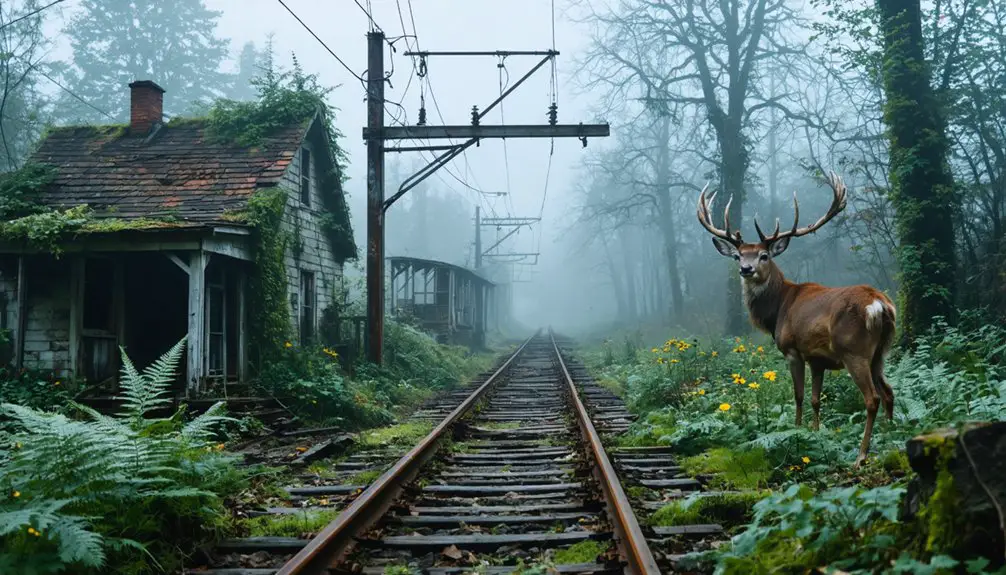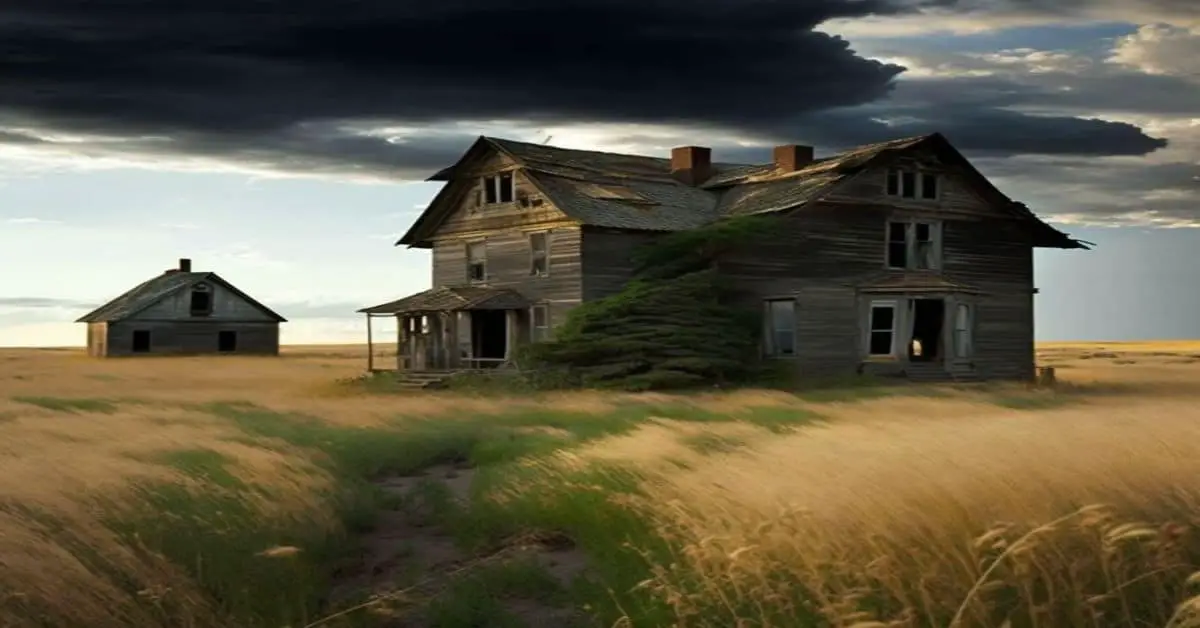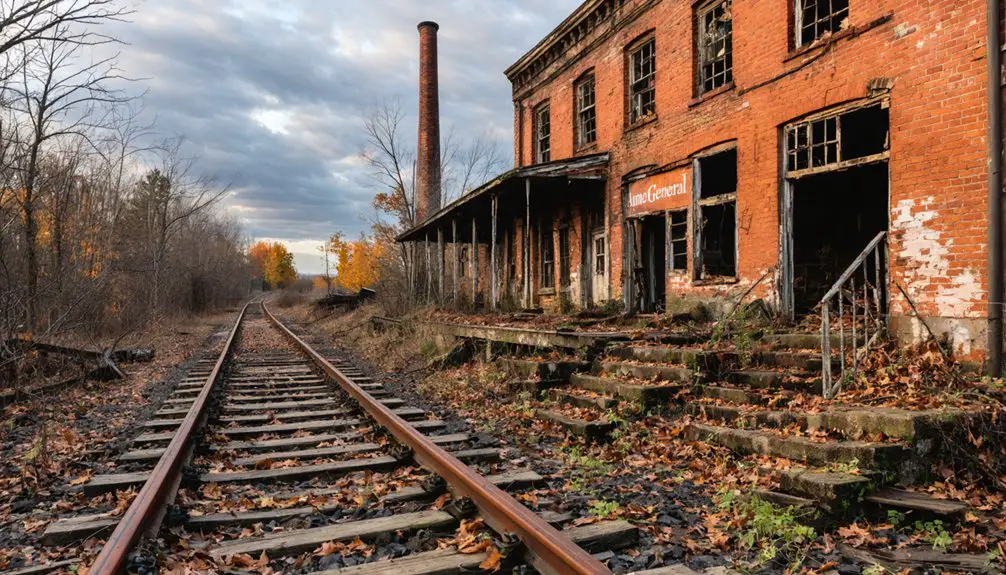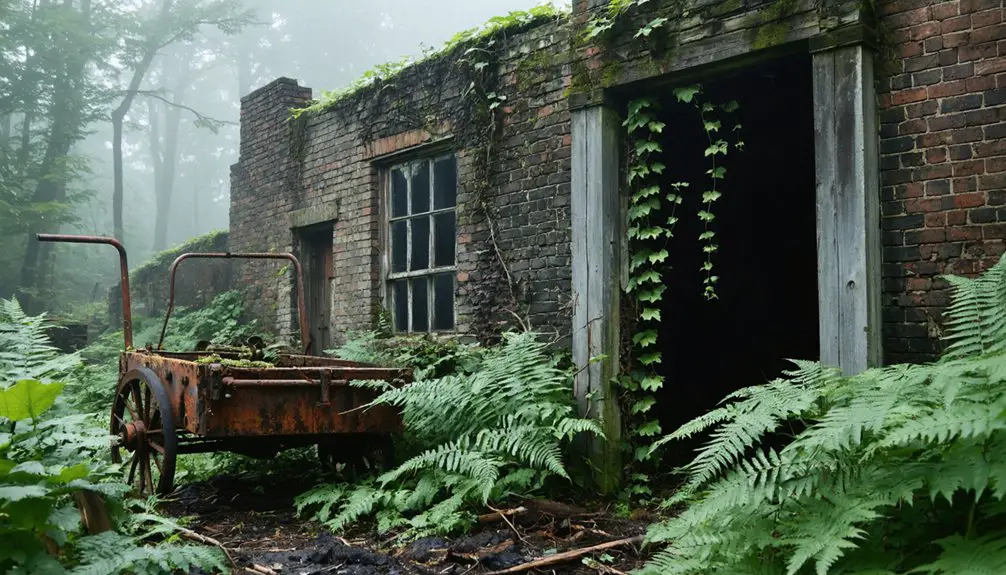You’ll find Kinzua, Pennsylvania hidden beneath the waters of the Allegheny Reservoir, submerged when the federal government built the Kinzua Dam in 1965. This former Seneca Nation settlement, whose name means “place of many fishes,” was home to over 600 residents before they faced forced relocation. The controversial dam project flooded 10,000 acres of treaty-protected land, destroying homes, sacred burial grounds, and centuries of cultural heritage. The untold stories of Kinzua’s displaced community still echo beneath the reservoir’s surface.
Key Takeaways
- Kinzua was a thriving Pennsylvania town submerged in 1965 due to the construction of the Kinzua Dam on the Allegheny River.
- The Army Corps of Engineers burned remaining structures in Kinzua before flooding, preventing residents from returning to their homes.
- Over 10,000 acres of land were flooded, destroying communities including Kinzua, Coldspring, Quaker Bridge, and Red House.
- The flooding displaced approximately 700 Seneca Nation members and 130 families from their ancestral lands and established communities.
- The ghost town now lies beneath the Allegheny Reservoir, with only remnants visible during periods of low water levels.
The Origins of Kinzua’s Name and Early Settlement
The name Kinzua, derived from Seneca Indian origins meaning “place of many fishes,” reflects the rich indigenous heritage of this Pennsylvania settlement along the Allegheny River.
You’ll find deep connections to the Seneca Nation throughout the region’s history, as they were the original inhabitants of these fertile fishing grounds.
Like many early settlements, the area faced challenges with Native American aggression that required strategic fortification and protection measures.
Among the earliest pioneers to bridge these two worlds was Philip Tome, who arrived between 1815 and 1827. As both a hunter and interpreter for Seneca leaders, Tome documented the area’s early days in his book “Pioneer Life, or Thirty Years a Hunter.”
His settlement helped establish the foundation for what would become a thriving community, where Kinzua heritage emerged from the blending of Native American traditions and settler determination to build a new life in this resource-rich valley. The name would later inspire another settlement when E.D. Wetmore founded a lumber town called Kinzua in Wheeler County, Oregon in 1927.
The Devastating Impact of the Kinzua Dam Project
When you examine the Kinzua Dam project’s toll on the Seneca Nation in the early 1960s, you’ll find the forced relocation of over 600 tribal members and the flooding of more than 10,000 acres of their ancestral reservation lands.
You’re looking at a stark violation of the 1794 Pickering Treaty, which had guaranteed the Seneca’s right to their territory “forever.”
The devastation went beyond physical displacement, as sacred burial grounds disappeared beneath the waters, traditional hunting and fishing territories were lost, and entire communities were fractured by new infrastructure and dispersal.
Despite the human cost, the project has prevented an estimated flood damages exceeding $1.2 billion since its completion in 1965.
Dr. Arthur Morgan proposed an alternative smaller dams plan that could have prevented the destruction of Seneca lands while still providing flood control, but federal authorities rejected it.
Forced Seneca Nation Relocation
Despite promises made in the 1794 Treaty of Canandaigua, signed by President George Washington himself, nearly 700 Seneca Nation members faced forced relocation in the 1960s when the U.S. government authorized construction of the Kinzua Dam.
You’ll find that this displacement shattered tight-knit communities like Red House and Coldspring, as the Army Corps of Engineers enforced flowage easements in the flood zone.
The government’s actions defied cultural preservation efforts, submerging not just homes but also burial grounds, hunting areas, and community gathering spaces. Civil engineer Arthur Morgan proposed the Conewango-Cattaraugus Plan as an alternative solution that would have prevented the flooding of Seneca lands. For historical acknowledgment, it’s important to recognize that officials deliberately burned evacuated structures before flooding the reservoir.
While the government built new housing developments, the relocation fractured social bonds and disrupted the transmission of Seneca language and traditions, leaving lasting scars on the community’s cultural fabric. Eleanor Roosevelt called the displacement a shameful thing, highlighting the national controversy surrounding the project.
Environmental Changes and Loss
As construction of the Kinzua Dam submerged over 10,000 acres of Seneca ancestral lands in the 1960s, you’d witness one of the most significant environmental transformations in Pennsylvania’s history.
The rising waters didn’t just drown communities – they released widespread environmental degradation across the region’s delicate ecosystems.
You’ll find the dam’s creation dramatically altered the Allegheny River’s natural flow, creating an ecological imbalance that still affects fish populations today.
The Allegheny Reservoir stretches 27 miles long and spans 120 feet deep at its maximum depth.
Sediment buildup near the reservoir’s northern border has changed upstream habitats, while increased development has intensified flooding in smaller tributaries.
Though the dam helps regulate water quality, climate change and shifting rainfall patterns continue to threaten this fragile balance. Despite environmental concerns, the project has prevented over $1.2 billion in flood damages since its completion in 1965.
The loss extends beyond the physical – sacred burial grounds, hunting territories, and fishing spots essential to Seneca culture now lie silent beneath the waters.
Treaty Violations and Resistance
The Kinzua Dam project‘s environmental devastation parallels an even deeper betrayal – the U.S. government’s violation of the 1794 Canandaigua Treaty. When you examine this breach of indigenous sovereignty, you’ll find a stark disregard for treaty enforcement that changed the Seneca Nation forever.
The government’s actions against the Seneca people included:
- Forcibly displacing nearly 700 individuals from their ancestral lands
- Flooding over 9,000 acres of treaty-protected territory
- Burning entire towns like Red House and Coldspring to prevent reoccupation
- Dividing the relocated community with a new highway
Despite legal challenges and public protests, the courts upheld federal eminent domain powers over treaty rights. The U.S. District Court ruled against the Seneca Nation in early 1957, determining they could not prevent federal agents from accessing their land.
The Seneca’s resistance through legal battles and public awareness campaigns highlighted the ongoing struggle for indigenous sovereignty during the Cold War era.
Seneca Nation’s Forced Relocation and Cultural Loss
You’d have recognized the profound injustice when the U.S. government breached the 1794 Treaty of Canandaigua by seizing Seneca lands through eminent domain for the Kinzua Dam project.
The flooding submerged nearly 10,000 acres of ancestral Seneca territory, including sacred burial grounds and historically significant sites that had sustained their culture for generations. Despite having an average family income of $3,000, the Seneca people fought tirelessly through legal and protest efforts to protect their homeland.
The forced displacement of 700 Seneca people shattered tight-knit communities like Coldspring and Red House, dispersing families and disrupting traditional ways of life that had endured for centuries along the Allegheny River.
Treaty Rights Violated
When President George Washington signed the Treaty of Canandaigua in 1794, he guaranteed the Seneca Nation permanent ownership of their ancestral lands – a promise that would be broken less than two centuries later.
The treaty’s violation demonstrates a stark disregard for indigenous sovereignty and treaty enforcement.
You’ll find these critical breaches of the agreement:
- The U.S. government seized 10,000 acres of guaranteed Seneca territory through eminent domain.
- Federal authorities ignored President Basil Williams’ 1961 appeal to President Kennedy.
- Pittsburgh business interests successfully lobbied to override treaty protections.
- Courts failed to uphold the Seneca Nation’s legal rights during 1957-1958 hearings.
This betrayal of the Canandaigua Treaty set a dangerous precedent for federal-tribal relations and highlighted the vulnerability of Native American land rights.
Ancestral Lands Submerged
Nearly 700 Seneca people watched helplessly as rising waters from the Kinzua Dam consumed their ancestral homeland in 1965, submerging over 10,000 acres of guaranteed territory along the Allegheny River.
You’ll find their submerged heritage in places like Coldspring, Quaker Bridge, and Red House – communities now lost beneath the reservoir’s depths.
The Army Corps of Engineers burned what remained, destroying homes, wood stoves, and gardens that had sustained generations. This forced relocation scattered over 130 families, fragmenting tight-knit communities and disrupting ancestral memory passed down through generations.
The flooding erased sacred sites and traditional gathering places where the Seneca language once flourished. While some families resettled in nearby Steamburg to maintain connections to their drowned homeland, the cultural wounds of this displacement continue to shape Seneca identity today.
Community Bonds Shattered
Although federal authorities claimed the Kinzua Dam served the public good, its construction shattered generations of Seneca community bonds and cultural traditions.
You’d find the devastating impacts reflected in:
- The forced separation of nearly 130 Seneca families from their established communities in Coldspring, Quaker Bridge, and Onoville
- The flooding of sacred burial grounds and cultural landmarks that had anchored Seneca identity since the 18th century
- The disruption of traditional living patterns and social networks that had fostered community resilience
- The severing of cultural connections to ancestral lands where ceremonies and gatherings once strengthened tribal bonds
Despite receiving monetary compensation, the Seneca people’s loss transcended financial measures.
Their displacement fractured longstanding relationships, disrupted ceremonial practices, and forever altered the fabric of their society – wounds that continue to shape their collective memory today.
Engineering Marvel: The Rise and Fall of Kinzua Viaduct
In an extraordinary feat of 19th-century engineering, the Kinzua Viaduct rose above Pennsylvania’s rugged terrain as the world’s tallest railroad bridge in 1882.
You’ll marvel at how engineer Octave Chanute‘s innovative design used Phoenix columns – hollow wrought iron tubes that provided remarkable strength while staying lightweight. The original structure, standing 301 feet tall and stretching 2,053 feet, demonstrated incredible engineering innovation by being built without scaffolding in just 94 working days.
The viaduct’s historical significance grew even stronger when it was completely rebuilt in steel during 1900, doubling its weight to support heavier trains.
After serving the region’s coal, timber, and oil industries for nearly eight decades, you can now find its remains at Kinzua Bridge State Park, where a 2003 tornado left behind haunting ruins of this once-mighty structure.
Life Beneath the Waters: A Submerged Community
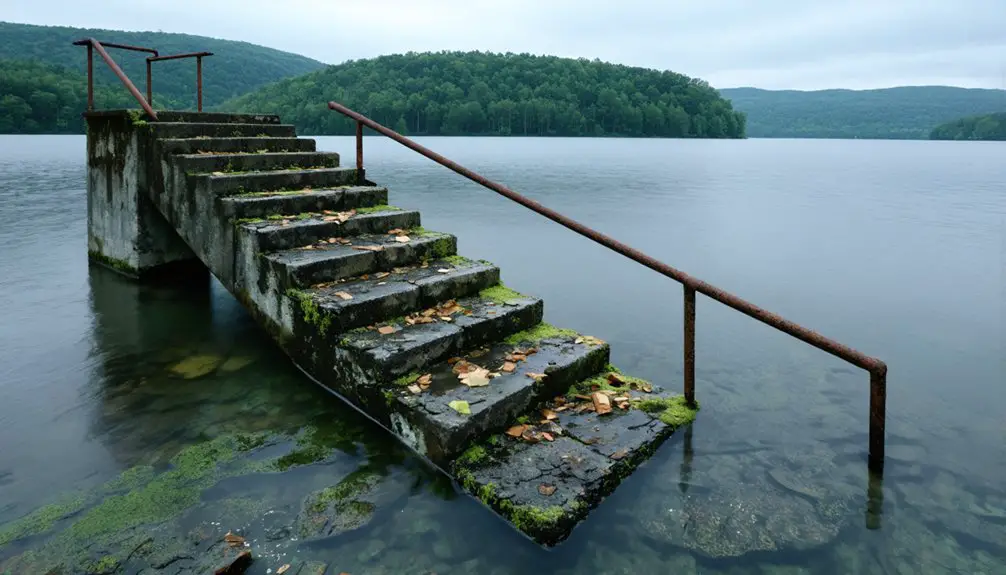
While the Kinzua Viaduct stood as a tribute to engineering ambition, the creation of Kinzua Dam brought devastating changes to the communities below.
You’ll find a submerged history beneath the Allegheny Reservoir’s waters, where over 600 families once called this valley home. The Army Corps of Engineers forever altered this landscape, leaving only memories of thriving towns like Red House and Coldspring.
The impact on community identity was profound:
Displacement shattered more than homes – it severed the cultural threads that had woven communities together for generations.
- Traditional Seneca homes and burial grounds now rest beneath 9,000 acres of water
- The oldest active U.S. treaty was broken, shattering trust between nations
- Language and cultural practices declined as communities were split apart
- The Seneca dubbed it the “Lake of Perfidy,” marking their deep sense of betrayal
Legacy and Remembrance: From Thriving Town to Historical Site
Today, the legacy of Kinzua lives on through dedicated preservation efforts and storytelling initiatives that keep the town’s memory alive.
You’ll find historical markers and documentaries like “Lake of Betrayal” that chronicle both settler history and the profound loss experienced by the Seneca Nation. The Warren County Historical Society maintains essential records and artifacts from the pre-dam era, while community resilience shines through oral histories passed down by displaced residents and their descendants.
Cultural preservation remains paramount, especially for the Seneca people who lost their ancestral Cornplanter Tract and saw over 600 families displaced.
Through photographs, films, and archived materials, you can trace Kinzua’s evolution from its 1821 founding through its final days, understanding both the township’s pioneer spirit and the devastating impact of its submergence.
Frequently Asked Questions
What Wildlife Species Were Affected by the Flooding of Kinzua?
You’ll be shocked how the flooding devastated wildlife habitat for countless species – from trout and endangered mussels to foxes and bobcats, creating a massive ecological impact on Pennsylvania’s native aquatic and terrestrial creatures.
Are There Any Remaining Buildings From Kinzua Visible During Low Water?
You won’t find intact buildings from Kinzua’s history during low water – only deteriorated foundations and concrete rubble remain visible. Most submerged structures have eroded away after decades underwater.
What Compensation Did Displaced Residents Receive for Their Lost Properties?
You’d be shocked that displaced residents received fair market value buyouts based on property valuation assessments, plus relocation assistance, though many felt the compensation didn’t truly cover their devastating losses and disrupted lives.
Can Visitors Scuba Dive to Explore the Submerged Town Ruins?
You won’t find organized scuba diving or underwater exploration of the submerged ruins. While structures exist beneath Allegheny Reservoir’s waters, there’s no confirmed access or sanctioned diving programs exploring these historical remains.
What Seasonal Recreational Activities Are Available Around the Kinzua Reservoir Today?
You’ll find endless boating opportunities from spring through fall, prime fishing hotspots year-round, extreme water sports in late summer, plus hiking trails and winter activities like cross-country skiing and ice fishing.
References
- https://riversofsteel.com/_uploads/files/The Kinzua Dam Controversy.pdf
- https://crookcountyhistorycenter.org/2022/07/kinzua-a-logging-company-owned-community/
- https://www.roadunraveled.com/blog/kinzua-bridge-viaduct/
- https://uncoveringpa.com/ghost-towns-in-pa
- https://www.youtube.com/watch?v=qinUza6H61I
- https://www.warrenhistory.org/Places and Names by Ernie Miller.html
- https://www.youtube.com/watch?v=inRD6vYBy8M
- https://www.butlereagle.com/20230711/kinzua-dam-a-triumph-and-tragedy-on-the-allegheny-river/
- https://www.lrd.usace.army.mil/Missions/Projects/Display/Article/3641480/kinzua-dam-allegheny-reservoir/
- https://lumberheritage.org/things-to-do/kinzua-dam-allegheny-reservoir/
